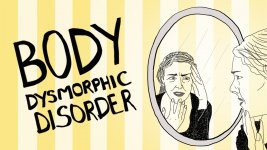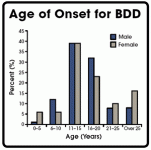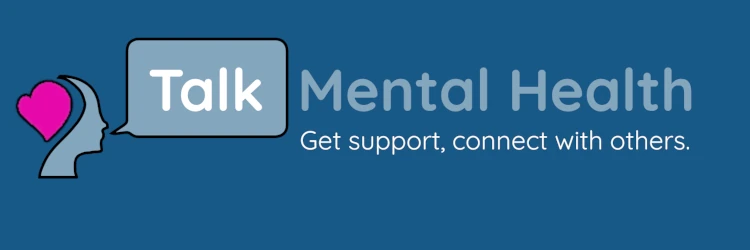
Body dysmorphic disorder (BDD), or body dysmorphia, is a mental health condition characterised by an individual’s intense preoccupation with one or several aspects of their appearance[1],[2]. It causes high levels of distress and impacts on a patient’s daily functioning. The preoccupation occurs with one or more perceived defects or flaws in appearance that is typically either unnoticeable or only slightly noticeable to others. For example, someone may have a preoccupation about uneven skin or acne, with no visible or very slight acne or blemishes. The most common areas of preoccupation are around the face (e.g. nose, skin, eyes, eyelids, mouth, jaw and chin), although the preoccupation can be about any part of the body, can move around the body and may include several different areas[3].
The disorder tends to develop during adolescence; however, on average, individuals wait years before a diagnosis is made[4],[5].The high levels of shame experienced with this condition, coupled with relatively poor understanding of it, mean that BDD can be a ‘hidden’ disorder, with many individuals going for years before accessing treatment.
A systematic review has shown the prevalence of BDD to be around 2% in the general adult population[6],[7]. Since individuals with this condition believe their difficulties to have a physical basis, rather than a psychological basis, the prevalence of BDD has been reported to be higher in cosmetic and dermatological settings (around 10%) because patients present there in an effort to change the area of concern[4].
This article will describe the main signs and symptoms of BDD, as well as the main psychological and pharmacological therapies available to manage the condition.
Signs and symptoms

BDD is characterised by a range of activities aimed at minimising, hiding, checking or reducing the impact of the concerning feature. These acts are often compulsive or repetitive. For example, an individual may spend several hours in the shower each day with the intention of ensuring they are clean and that there are no germs on their skin, which may lead to acne.
Although these behaviours are carried out in order to reduce anxiety, they often serve to increase levels of anxiety and reinforce the beliefs that maintain the condition. Compulsive behaviours and routines may include:
Checking
- Looking in mirrors or any reflective surfaces (e.g. a window);
- Feeling the feature they are anxious about using their fingers;
- Taking photos of themselves to check their appearance.
Camouflage
- Wearing clothes (e.g. hats/scarves) to hide the features;
- Wearing excessive make-up;
- Posturing to hide the feature;
- Styling hair in certain ways (e.g. to minimise asymmetry of the face or hide the jawline).
Reassurance seeking
- Asking others for reassurance about appearance;
- Comparing with pictures taken in the past to check there has been no change.
Other ritualistic/repetitive behaviours
- Hair removal;
- Skin picking;
- Grooming;
- Particular beauty routines.
Avoidance of:
- People;
- Reflective surfaces;
- Daylight/sunshine;
- Certain lighting;
- Specific groups of people (e.g. teenagers who may be more likely to ridicule them);
- Photographs;
- Wind (in case it ruffles carefully groomed hair).

In more severe cases, an individual may spend hours performing their grooming rituals, waiting until a time where they feel ‘OK’, or ‘just right’, or when they feel that the feature is hidden sufficiently to allow them to interact with others. Many individuals with BDD are housebound and find any social interaction almost impossible.
Obsessions and compulsions that are not related to appearance may indicate obsessive compulsive disorder (OCD)[8].
Causes and risk factors
The causes of BDD are not well researched, but they are thought to be similar to those of other psychological disorders and may include genetics (e.g. family history of BDD), history of childhood adversity (e.g. abuse or bullying), certain parental interaction styles (e.g. being excessively critical), certain temperaments (e.g. low self-esteem) and a history of a physical or dermatological condition[3].Veale et al. noted that individuals with this condition often have an interest or background in art and design, and were more likely than patients with other psychiatric conditions to have an education or occupation in these areas[9]. Similar findings were reported by Lambrou, who observed that 20% of a BDD group had a background in art/design, compared with 0% in a matched control group[10]. It is yet to be established if this observation is a predisposing factor or a consequence of having the condition[3].
Furthermore, it is usual for individuals with BDD to have comorbid conditions, and often it is these conditions that prompt the individual to seek treatment. For example, a patient may be diagnosed with agoraphobia (i.e. a fear of being in situations where escape might be difficult or where help would not be available if things go wrong) because they are unable to leave the house. However, this fear may actually be driven by BDD-related concerns.

Management
The guideline for the treatment of BDD by the National Institute for Health and Care Excellence (NICE) was published in 2005[8] and, as of February 2019, is being updated[11].A stepped-care model for medicine management is currently recommended, with the aim of providing the most effective treatments with fewest side effects.
Psychological treatment
NICE recommends cognitive behavioural therapy (CBT) for mild functional impairment BDD, which can be offered individually or in a group. The focus of CBT is to help patients manage their symptoms by changing the way they think and behave, such as providing them with neutralising strategies for self-focused attention, and to help them reduce avoidance and repetitive behaviours.This usually includes a technique known as exposure and response prevention (ERP), which involves gradually facing situations that normally make the patient think obsessively about their appearance and feel anxious, in the hope that over time they will be able to deal with these feelings of extreme self-consciousness.
In cases of moderate functional impairment, patients should be offered either CBT or pharmacological treatment, whereas patients with severe functional impairment should be offered CBT and pharmacological treatment.
It is worth noting that there is a paucity of evidence for the psychological treatment of BDD and there is a need for large-scale, randomised controlled trials (RCTs) to determine the true efficacy of CBT, the optimal conditions of CBT and the durability of this treatment modality in this group of patients.

Pharmacological treatment
Published evidence from RCTs suggest that selective serotonin reuptake inhibitors (SSRIs) are effective in treating BDD[12],[13]. However, healthcare professionals in the field have suggested that higher doses of SSRI medicines are required for the treatment of BDD compared with depression[14].NICE recommends fluoxetine as the first-line pharmacological treatment for BDD (including for patients with beliefs that are delusions) because there is more evidence for its effectiveness in treating BDD compared with other SSRIs[8]. However, it should be noted that fluoxetine does not have a UK marketing authorisation for use in BDD[15]. Possible side effects of fluoxetine include reduced appetite and insomnia. It can also cause drowsiness; therefore, it may not be suitable for people who need to drive for work or who operate heavy machinery.
If the patient responds poorly to fluoxetine (when taken consistently for 12 weeks at the maximum tolerated dose), or if they cannot tolerate the side effects, fluoxetine can be switched to an alternative SSRI (e.g. escitalopram) or the tricyclic antidepressant clomipramine. Prior to initiation, clomipramine’s side effect profile, including its potential adverse effect on the cardiovascular system, should be carefully considered — baseline electrocardiogram and blood pressure readings should be offered to exclude cardiovascular abnormalities[8].
For patients with a significant risk of suicide, clomipramine should only be prescribed in small quantities at a time owing to its toxicity in overdose[8]. If treatment with an SSRI or clomipramine are effective, they should be continued for at least 12 months to prevent relapse and to allow for further improvements[8].
Combination therapy
According to the NICE guidelines, psychological therapy should be considered at each stage of the treatment process and added to the treatment regimen if considered appropriate and if the patient is motivated to engage[8]. No published research trials have examined whether SSRIs enhance the outcome of CBT for BDD, although clinical experts have suggested from their own experience that this is a useful strategy for severe BDD[8].Children and young people
Fluoxetine or sertraline should be used in children and young people aged under 18 years with BDD[16]. This medicine should be continued for at least six months post-remission. When stopping the medicine, the dose should be tapered gradually over several weeks to minimise discontinuation symptoms.Although SSRIs may increase the risk of suicidal thoughts and self-harm in young people with depression, it is unclear whether this risk is increased for individuals with BDD. For children and young people with BDD who also have comorbid depression, the NICE guideline for the treatment of childhood depression should be followed[17].
Monitoring
Healthcare professionals should actively monitor patients for signs of akathisia (a movement disorder), suicidal ideation (particularly in children aged under 18 years) and increased anxiety or agitation, particularly in the initial stages of SSRI treatment and following dose increases. Patients should be advised to seek help promptly if symptoms worsen or if they experience side effects from the medicine.If there has been no response to a full trial of combined treatment with CBT, including ERP, an SSRI and a full trial of clomipramine, the options are to:
- Add buspirone to the SSRI;
- Refer the patient to a specialist team with expertise in BDD for further psychological therapy.
Antipsychotics are not usually recommended as an augmentation strategy for treating BDD (including beliefs of delusional intensity), owing to the lack of evidence that this is effective[16], although antipsychotics may sometimes be helpful to relieve particular symptoms, such as agitation.
Accessing treatment
The BDD Foundation offers advice, support and guidance about this condition, along with information on how to access treatment[18]. Psychological therapy can be provided by healthcare professionals in local teams with particular skills and expertise in BDD. Alternatively, there are several specialist centres for treating BDD in the UK, known as a highly specialised service, which treats patients with severe symptoms[18].Role of the pharmacist
It is important to acknowledge that shame associated with the condition means that it can be difficult for individuals to seek treatment, on account of a fear of being ridiculed for being vain or of having their difficulties minimised. Therefore, pharmacists and members of the pharmacy team should use considered language when talking to patients about BDD so as to not further contribute to the patient’s feelings of shame and stigma.The outlined interventions can be used by pharmacists, employing their specific skill set to help people with BDD:
- Be prepared — in BDD, it can be difficult for patients to engage in a psychological understanding, which can be a barrier to good engagement. It is particularly important to anticipate and allow for shifting insight and engagement, and to focus on helping a patient to understand and manage their levels of distress. Conversations or reassurance about the feature itself (e.g. the perceived asymmetry of the face) are unhelpful and should be avoided. Instead, discussions should be about the preoccupation, its impact, the levels of distress and factors that may serve to maintain the distress (e.g. taking constant photos of themselves to check their appearance).
- Use sensitive language — similarly, using language such as ‘defect’ or ‘imagined flaw’ (although used in diagnostic terminology) can also be unhelpful because from the patient’s perspective they can serve to minimise the impact of the condition and can feel invalidating. Instead, terms such as ‘preoccupation’ or ‘area of concern’ can assist patients to engage in a psychological understanding of their difficulties.
- Educate and inform — pharmacists can explain to patients how to take their medicines, as well as how to manage any side effects. They can also signpost patients who have worsening symptoms to a GP or a mental healthcare professional.
References
[1] Veale D & Matsunaga H. Body dysmorphic disorder and olfactory reference disorder: proposals for ICD-11. Braz J Psychiatry2014;36(1):14–20. PMID: 25388608[2] American Psychiatric Association. Diagnostic And Statistical Manual of Mental Disorders (DSM-5). 2019
[3] Veale D & Neziroglu F. Body Dysmorphic Disorder: A Treatment Manual. London: John Wiley; 2010
[4] Veale D, Gournay K, Dryden W et al. Body dysmorphic disorder: a cognitive behavioural model and pilot randomized controlled trial. Behav Res Ther 1996;34(9):717–729. doi: 10.1016/0005-7967(96)00025-3
[5] Phillips KA & Diaz SF. Gender differences in body dysmorphic disorder. J Nerv Ment Dis 1997;185(9):570–577. doi: 10.1097/00005053-199709000-00006
[6] Veale D, Gledhill L, Christodolou P & Hodsoll J. Body dysmorphic disorder in different settings: a systematic review and estimated weighted prevalence. Body Image 2016;18:168–186. doi: 10.1016/j.bodyim.2016.07.003
[7] Koran LM, Abujaoude E, Large MD & Serpe RT. The prevalence of body dysmorphic disorder in the United States adult population. CNS Spectrums 2008;13:1–7. doi: 10.1017/S1092852900016436
[8] National Institute for Health and Care Excellence. Obsessive-compulsive disorder and body dysmorphic disorder: treatment. NICE guideline [CG31]. 2005. Available at: https://www.nice.org.uk/guidance/CG31 (accessed September 2019)
[9] Veale D, Ennis M & Lambrou C. Possible association of body dysmorphic disorder with an occupation or education in art and design. Am J Psychiatry 2002;159:1788–1790. doi: 10.1176/appi.ajp.159.10.1788
[10] Lambrou C. The Role of Aesthetic Sensitivity in Body Dysmorphic Disorder. London: Institute of Psychiatry; 2006.
[11] National Institute for Health and Care Excellence. 2019 surveillance of obsessive-compulsive disorder and body dysmorphic disorder: treatment (NICE guideline CG31). Surveillance decision. Available at: https://www.nice.org.uk/guidance/cg...45/chapter/Surveillance-decision?tab=evidence (accessed September 2019)
[12] Phillips KA, Albertini RS & Rasmussen SA. A randomized placebo-controlled trial of fluoxetine in body dysmorphic disorder. Arch Gen Psychiatry2002;59(4):381–388. doi: 10.1001/archpsyc.59.4.381
[13] National Institute for Health and Care Excellence. Static list — candidate guidelines post consultation. 2014. Available at: https://www.nice.org.uk/guidance/cg31/evidence/review-decision-february-2014-pdf-546203053(accessed September 2019)
[14] Phillips KA, Keshaviah A, Dougherty D et al. Pharmacotherapy relapse prevention in body dysmorphic disorder: a double-blind, placebo-controlled trial. Am J Psych 2016;173(9):887–895. doi: 10.1176/appi.ajp.2016.15091243
[15] BNF. Fluoxetine. Available at: https://bnf.nice.org.uk/drug/fluoxetine.html(accessed September 2019)
[16] Phillips KA. Body dysmorphic disorder: recognizing and treating imagined ugliness. World Psychiatry 2004;3(1):12–17. PMID: 16633443
[17] National Institute for Health and Care Excellence. Depression overview. 2018. Available at: https://pathways.nice.org.uk/pathways/depression(accessed September 2019)
[18] Body Dysmorphic Disorder Foundation. BDD. 2019. Available at: https://bddfoundation.org (accessed September 2019)
Citation
The Pharmaceutical Journal, September 2019;OnlineOI:10.1211/PJ.2019.20206935

Recognising and managing body dysmorphic disorder
A range of symptoms can indicate potential body dysmorphic disorder. Pharmacists should know how to have conversations about this condition and provide advice about the available treatments.pharmaceutical-journal.com
